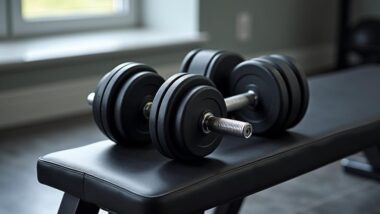Kettlebell Exercises for Hips
You’re targeting the right Kettlebell Exercises for Hips to improve your hip strength, mobility, and overall athletic performance.
When choosing the best kettlebell exercises for your hips, consider your hip mobility range, muscle target priority, weight load capacity, and exercise variety needs.
Proper body alignment is vital to avoid injury and guarantee correct muscle engagement.
Effective exercises like hip thrusts can be modified to suit your fitness level and engage multiple muscle groups simultaneously.
By incorporating these exercises into your routine, you’ll be on your way to stronger, more stable hips.
Now, get ready to uncover more exercises that will take your hip training to the next level.
Key Takeaways
- Consider hip mobility range and muscle target priority when choosing kettlebell exercises to improve overall hip health and athletic performance.
- Start with a weight load capacity that allows for proper form and control, and gradually increase the load as strength and endurance improve.
- Incorporate a variety of exercises that target different muscle groups, such as hip thrusts, squats, and lunges, to ensure overall hip strength and stability.
- Prioritize proper body alignment to guarantee even weight distribution and correct muscle targeting, reducing the risk of injury.
- Choose lower-impact exercises like hip thrusts to reduce the risk of hip strain and ensure a safe and effective workout.
OG Belt – Bellabooty Exercise Hip Thrust Belt
If you’re looking to take your hip exercises to the next level, the OG Belt – Bellabooty Exercise Hip Thrust Belt is the best choice for serious weightlifters who need a reliable and comfortable solution.
This belt can handle weights up to 400 lbs and works with dumbbells, kettlebells, and plates. You’ll appreciate the plush padding and secure grip that provide hip protection and comfort during your workouts.
The patented design guarantees flawless balance and stability, and you can set it up quickly in under 20 seconds.
Whether you’re doing hip thrusts, squats, lunges, or other exercises, this belt is versatile and suitable for home, gym, or on-the-go workouts.
Best For: Serious weightlifters who need a reliable and comfortable solution for their hip exercises.
Pros:
- Handles heavy weights up to 400 lbs with ease and comfort
- Provides plush padding and secure grip for hip protection and comfort
- Quickly sets up in under 20 seconds and is suitable for various exercises and workouts
Cons:
- Some users report minor issues with the product, such as the band being stiff
- Weights may hit the floor during use, causing potential distraction or disruption
- No specific mention of a warranty or return policy is provided
Factors to Consider When Choosing Kettlebell Exercises for Hips
When choosing kettlebell exercises for your hips, you’ll want to ponder your hip mobility range to guarantee you’re performing exercises that work within your comfortable range of motion.
You’ll also need to prioritize which muscles you want to target, as different exercises will engage different muscle groups.
Also, you’ll need to think about your weight load capacity, exercise variety needs, and the importance of maintaining proper body alignment.
Hip Mobility Range
As you prepare to incorporate kettlebell exercises into your hip training regimen, it’s essential to reflect on the hip mobility range, a critical factor in choosing the most effective exercises for your hips.
Your hip mobility range refers to the ability of your hip joint to move through a full range of motion, including flexion, extension, abduction, adduction, internal rotation, and external rotation.
A normal hip mobility range includes 120-140 degrees of flexion, 10-15 degrees of extension, 40-50 degrees of abduction, and 20-30 degrees of internal rotation.
If you have a restricted hip mobility range, you may experience issues like hip impingement, lower back pain, and decreased athletic performance.
Factors like muscle imbalances, joint laxity, and previous injuries or surgeries can affect your hip mobility range.
By understanding your hip mobility range, you can choose kettlebell exercises that target your specific limitations and improve your overall range of motion.
Muscle Target Priority
Now that you’ve assessed your hip mobility range, it’s time to prioritize the specific muscles you want to target with kettlebell exercises.
Your hips are a complex joint, and different exercises will engage different muscle groups. You’ll want to focus on exercises that target your glutes, hamstrings, and hip flexors.
When choosing kettlebell exercises, weigh your fitness goals and what you’re trying to achieve. Are you looking to improve hip stability, increase strength, or enhance mobility?
Depending on your goals, you may want to prioritize exercises that target your gluteus maximus, gluteus medius, or iliopsoas muscles.
For example, if you’re looking to improve hip stability, you’ll want to focus on exercises that target your gluteus medius, such as the kettlebell sumo squat or kettlebell side lunge.
Remember to ponder your current fitness level and any muscle imbalances you may have. If you have weak glutes, you’ll want to prioritize exercises that target those muscles.
By targeting the right muscles with the right exercises, you’ll be able to achieve your fitness goals and improve your overall hip health.
Weight Load Capacity
You’re faced with a wide range of kettlebell weights, from light to heavy, and selecting the right one is crucial for effective hip exercises.
The weight you choose will impact the intensity of your workout and the results you achieve. If you’re just starting out, you may want to begin with a lighter weight and gradually increase the load as your strength and endurance improve.
It’s essential to reflect on your fitness level, goals, and the specific exercises you’ll be performing when choosing a kettlebell weight.
For example, if you’re doing swings or cleans, you’ll want a weight that allows you to maintain proper form while still challenging your hips. For slower, more controlled movements like lunges or deadlifts, you may opt for a heavier weight.
Remember, it’s better to err on the side of caution and start with a lighter weight, gradually increasing the load as you become more comfortable with the exercises.
Exercise Variety Needs
Choosing the right kettlebell exercises for your hips involves more than just selecting a weight; it’s about incorporating a variety of exercises that target different muscle groups, planes of motion, and aspects of hip function.
You’ll want to include exercises that target different muscle groups, such as hip thrusts, squats, and lunges, to guarantee overall hip development and prevent plateaus. Incorporating exercises that work multiple planes of motion, like lateral lunges and curtsy lunges, will help improve hip function and stability.
Don’t forget to include exercises that target the gluteus medius, like side-lying leg lifts, which can help improve hip stability and reduce the risk of injury. You should also incorporate exercises that challenge hip mobility, such as sumo squats and step-ups, to improve range of motion and reduce stiffness.
Finally, include exercises that work the hip abductors, like cable rotations, to improve hip strength and stability. By incorporating a variety of exercises, you’ll be able to develop strong, stable, and mobile hips.
Body Alignment Importance
When selecting kettlebell exercises for your hips, it’s crucial to prioritize proper body alignment to guarantee the weight is evenly distributed and the muscles are targeted correctly. This confirms you’re working the right muscles and reducing the risk of injury.
Maintaining a neutral spine and engaging your core muscles helps you achieve this alignment, generating power from your hips rather than relying on your lower back.
If you don’t maintain proper alignment, you’ll put unnecessary stress on your joints, particularly your lower back and knees, leading to discomfort, pain, or even long-term damage.
During hip-focused exercises, your body should be aligned in a way that allows your hips to move freely, without restriction or compensation from other muscle groups.
By paying attention to your body alignment, you’ll develop muscle memory and awareness, enabling you to make adjustments and corrections as needed to maintain proper form and technique.
This attention to detail will help you get the most out of your kettlebell exercises and achieve peak results.
Injury Risk Reduction
Selecting the right kettlebell exercises for your hips requires careful consideration of several factors to minimize the risk of injury.
You’ll want to prioritize comfort and protection by using a hip thrust belt with proper padding and grip. It’s also vital to start with a weight that allows for proper form and control, as lifting weights that are too heavy can increase the risk of hip injury.
Poor form and balance during exercises like squats and lunges can put unnecessary stress on the hips, so consider using a belt with a patented design for balance and stability.
In addition, incorporate lower-impact exercises like hip thrusts into your routine to reduce the risk of hip strain caused by heavy weights or high-impact movements.
Don’t forget to warm up properly before exercising, as failing to do so can increase the risk of hip injury. By taking these factors into account, you can guarantee a safe and effective workout that targets your hips without putting them at risk.
Frequently Asked Questions
Can I Use Kettlebell Exercises for Hips if I Have Lower Back Pain?
If you’re experiencing lower back pain, you’re right to wonder if exercising is safe. You should consult a doctor or physical therapist to modify or avoid exercises that might exacerbate the issue.
How Often Should I Practice Kettlebell Exercises for Optimal Results?
When aiming for peak results, you should practice kettlebell exercises 2-3 times a week, allowing for 1-2 rest days in between, to avoid burnout and guarantee progressive overload, and you’ll start seeing improvements in no time.
Can Kettlebell Exercises Help With Hip Flexor Tightness?
You’re wondering if kettlebell exercises can help with hip flexor tightness – the answer is yes! As you swing, squat, and lunge, you’ll strengthen your glutes and hips, which can help loosen tight hip flexors and improve overall flexibility and mobility.
Are Kettlebell Exercises Suitable for Beginners or Advanced Only?
When you start gardening, you don’t begin with a jungle; you nurture a small seed. Similarly, kettlebell exercises aren’t just for pros; you can start with lighter weights and progress, making them suitable for beginners and advanced alike, with proper form and patience.
Can I Combine Kettlebell Exercises With Other Hip-Strengthening Exercises?
You’re wondering if you can combine kettlebell exercises with other hip-strengthening exercises, and the answer is yes, you can! You’ll get even better results by mixing kettlebells with other exercises that target your hips from different angles.
Conclusion
You’ve got this! By incorporating the best kettlebell exercises for hips into your routine, you’ll be rocking a stronger, more toned lower body in no time.
Remember, it’s all about finding the perfect balance of hip mobility, muscle target priority, and weight load capacity.
With a dash of exercise variety and a focus on proper body alignment, you’ll be flaunting your fabulous figure while keeping those pesky injuries at bay.
Happy lifting!




